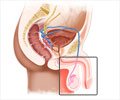Proteins from isolated cells known as circulating tumor cells, could be used as biomarkers to classify cancers more precisely.

- Circulating tumor cells (CTCs) are thought to break off from the original tumor and circulate in the blood.
- CTCs release proteins which could be used as biomarkers and these panel of proteins were measured using the microfluidic western blotting.
- The microfluidic device breaks the cells open and tests the cellular contents by introducing fluorescent probes that bind to and light up a specific protein target.
Circulating tumor cells are a potentially rich source of information about a person's cancer. These cells are thought to break off from the original tumor and circulate in the blood, and may be a sign of an aggressive tumor. The cells contain different proteins than the original tumor.
"Tremendous advances have been made in DNA and RNA profiling in cells collected using a liquid biopsy. We extend those advances to highly selective measurement of proteins - the 'molecular machines' of the cell," said Amy Herr, Berkeley a bioengineering professor and leader of the study team. "We are working to create medicine that would allow a doctor to monitor a patient's treatment response through a blood draw, perhaps on a daily basis."
Microfluidic Western Blotting
A key advance the team made was in devising a system to precisely handle and manipulate the concentrated cells from blood. They then analyzed each circulating tumor cell for the specific panel of cancer proteins.
The microfluidic device separates these large cells into a concentrated sample. It breaks the cells open and tests the cellular contents for eight cancer protein biomarkers.
The scientists were then able to identify cancer proteins by introducing fluorescent probes that bind to and light up a specific protein target. By sorting and probing the protein targets, the test is more selective than existing pathology tools. Enhanced selectivity will be crucial in detecting subtle chemical modifications to biomarkers that can be important but difficult to measure.
"Microfluidic design was key in this study. We were able to integrate features needed for each measurement stage into one process," Herr said. "Systems integration allowed us to do every single measurement step very, very quickly while the biomarkers are still concentrated. If not performed exceptionally fast, the cell's proteins diffuse away and become undetectable."
The researcher team is planning to identify more proteins using this technology which will allow pathologists to classify cancer cells more precisely than is possible using existing biomarkers.
This test may one day help patients may be able to monitor their body's response to cancer therapy just by having their blood drawn.
The study is published in the journal Nature Communications. The research was a collaboration with breast cancer surgeon Stefanie Jeffrey at Stanford University and with a University of California startup, Vortex Biosciences.
Reference
- Amy Herr et al. Profiling protein expression in circulating tumour cells using microfluidic western blotting. Nature Communications; (2017) doi:10.1038/ncomms14622
Source-Medindia















